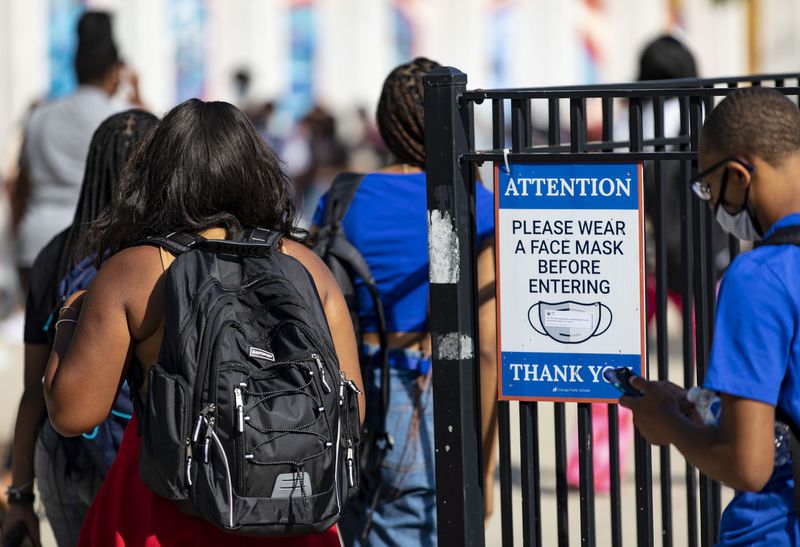CPS is reporting 481 COVID-19 cases and more than 9,600 potential exposures for the first three weeks of school
By TRACY SWARTZ
9/21/2021
Chicago Public Schools is reporting 481 COVID-19 cases for the first three weeks of school, with more than 9,600 people identified as close contacts of an infected person.
The data on the district’s public case tracker reflects 329 student cases and 152 adult cases for the period from Aug. 29 through Sunday. In the last seven days, 125 student and 47 adult cases were logged, according to the online tracker.
CPS has once again changed the type of COVID-19 case information it reports on its website and the frequency of updates. A spokesperson said the district will update its COVID-19 online tracker on a daily basis “in response to feedback.” A daily case breakdown is now provided.
The district’s new Virtual Academy for “medically fragile” students is now appearing in the data set, with zero cases reported. The data also includes the number of cases at non-school-based CPS locations, under the “administration” category (35 cases in the first three weeks, with 469 close contacts identified).
The district spokesperson said the “administration” term refers to the district’s central and network offices. “Currently, the district is not aware of any outbreaks at these locations,” the spokesperson said.

The tracker’s Sunday update shows more than 4,000 COVID-19 tests have been administered this school year through CPS’ screening program, with four people testing positive last week. In the past three weeks, 260 test results were deemed invalid, according to the district’s data.
CPS’ voluntary testing program is not expected to expand to all schools until the end of the month. Students and staff members were said to have been offered tests at some 170 schools last week.
Interim CPS CEO José Torres and incoming CEO Pedro Martinez are encouraging parents to sign their students up for the weekly testing.
“The next few weeks will be critical, and we all have a role to play. For the two of us, it will be working together to usher in a new era of stability for the district. For you, our families and school communities, it will be doing everything possible to keep this school year on track, including getting vaccinated and opting into school-based testing to slow the spread of COVID-19,” a Friday statement from the two leaders read.
The Chicago Teachers Union and some parents have blasted the district for the slow start to the testing program, which is mandatory only for unvaccinated staff members and unvaccinated or half-vaccinated student-athletes during their sports seasons. There are also concerns the district’s case tracker is not providing an accurate number of cases.
CTU is featuring reports of COVID-19 cases at tracker.ctulocal1.org. The union is set to hold a public forum at 5 p.m. Tuesday for parents, students, community groups and educators to share their experiences from the new school year, which began Aug. 30.
Looking at the data supplied by CPS, William Howard Taft High School in Norwood Park has reported 14 positive cases since the start of school, with 566 close contacts identified. John Palmer Elementary School in the Albany Park area has logged 12 cases, with 309 close contacts. Alexander Graham Bell Elementary School in the North Center community has seen eight cases, with 142 close contacts.
A close contact is defined as someone who was within 6 feet of an infected person for 15 or more minutes in a 24-hour period while masked or not. CPS is not instructing fully vaccinated, asymptomatic people to quarantine for the standard 14-day period. The vaccine is only available to people 12 years and older.
CPS boasted 341,000 students across more than 630 schools last year, but enrollment data is not available for this year. The district’s online case tracker only includes data from some 500 district-run schools and not charter or contract schools that are part of the CPS orbit, but are independently managed. A Southwest Side charter elementary school transitioned to remote learning last week after three cases were reported on a single day.
芝加哥公校强制疫苗接种 校车司机突集体辞职
文章来源:Chicago Tribune
8/30/2021

【芝加哥侨学网编译】8月30日,芝加哥公立学校(CPS)正式开学,这是疫情爆发一年多以来首次全面恢复正常上课。然而,校车司机们突发辞职潮,导致开学之际2000多名学生无校车接送。
CPS推行的新冠疫苗强制性接种政策,被认为是校车司机突发辞职潮的原因。
据《芝加哥论坛报》报道,在8月30日开学日的前一周,校车公司共有近90名司机宣布辞职,其中8月27日当天就有73名司机递交辞职信。突如其来的辞职潮,导致芝加哥公立学校校车系统的司机缺口高达近500人。
司机的短缺导致CPS系统2100多名学生将没有校车接送,并且这些学生以芝加哥市的“重点学校”(selective enrollment)为主。

Tel: 551-580-4856 | Email: F.WINNIE.S@GMAIL.COM
为了应对局面,CPS已决定将校车接学生上课的时间提前15至30分钟。对于无法享受校车接送的学生,CPS则将向家长们发放补贴,开学头两个星期为$1000,随后将变为每月$500。
芝加哥公立学校为此发布声明,向家长们致歉,并强调将尽快解决司机短缺问题。CPS在声明中指出,校车公司的司机们出现辞职潮可能与CPS推出要求雇员、合作网络职员必须接种新冠疫苗的强制性要求有关。
《纽约时报》近期报道显示,受疫情影响,全美范围内的用工荒、请人难问题已蔓延到食品、建筑行业,校车公司同样也深受影响,校车司机们辞职或提前退休已成为普遍现象。
CPS Offering Parents Cash Incentive As Bus Driver Shortage Forces Kids To Find Another Way To Class
By CBS 2 Chicago Staff
8/30/2021
CHICAGO (CBS) —Some kids may have to find another way to school Monday morning because there aren’t enough school bus drivers.
On Friday, 73 bus drivers quit. Now the district is short 500 drivers. And that means no rides for about 2,100 students.
CPS is offering affected families $1,000 in transportation stipends for the first two weeks of school and $500 dollars for the following months.
As of Saturday, about 12,400 students did have a bus route. Of those 5,500 would be affected by extended route times and would receive stipends.
What is Gap Insurance & Do You Need It?
7/18/2021

Purchasing commercial real estate can be a stressful process and each transaction carries some challenges during the closing process. This is especially true right now, as the real estate industry and commercial buyers and sellers navigate business deals during a pandemic. Title insurance helps to mitigate the risk of issues that may arise concerning your property transaction. Gap insurance is one of the resources to help overcome specific issues during the transaction process.
What is Gap Insurance?
Gap insurance is an endorsement added to the title policy that provides additional coverage for title defects that may arise during a gap period. To better understand why gap insurance is valuable, it is important to understand how the gap period is defined along with other elements that come into play when title is being transferred.
Gap Period
A gap period may refer to the span of time in either or both of the following scenarios:
There may be a time period between when a document is submitted for recording and when it is actually indexed by the recording office and available for search, usually a matter of days. This means that title commitments and subsequent date-down searches may not include documents that have not yet been indexed.
In some states, it is common for transactions to close a day or more before the insured documents can be recorded. If the title insurance policy is dated as of closing rather than recording, there can be a gap in coverage because the documents do not take effect until they are actually recorded. Recent government office closures due to COVID-19 concerns have made this scenario more prevalent than usual.
Title Commitment: Preliminary Report & Commitment for Insurance
The title commitment identifies the property to be insured, the owner of the property and any title defects that may not be covered by the insurance, which are listed exceptions to coverage. These commonly include things such as liens and easements.
Date-Down Search
Most title agencies perform the date-down search of public records concerning the insured property immediately before closing on a purchase or loan. This notifies the parties of any title matters appearing in the public records after the date of the title commitment.
Do you need Gap Insurance?
Most title insurance policies provide coverage for defects that may arise during the gap period caused by indexing and search availability and coverage is generally not required. However, when a title policy is dated effective at closing, rather than recording, a gap insurance endorsement is added to title insurance to cover any items that may be discovered after the closing date (policy date) and before the recording date.
Landmark Title is Here for You
The Landmark Title team is highly experienced in handling complex real estate transactions. We are committed to taking care of all your escrow and title needs, providing a comprehensive, personal approach.
If you have questions about Gap Coverage or have questions regarding title services, please contact us at (602) 748-2800 or info@ltaz.com.
How To Evict a Squatter: Why You Need To Act Quickly
By Eric Worral
7/04/2021
While squatters taking over your property might seem like something out of an old Western movie, it’s a very real thing that could happen to you or any other landlord.
Squatters in modern times are less likely to be outlaws trying to steal your property from you and are more likely to be disgruntled tenants or their friends who don’t want to pay to live on your land. That’s right; the tenants that you rent to can become squatters!
While this progression is thankfully not very common, the fact that it is relatively rare makes it an even more difficult situation for landlords to deal with. Most landlords wouldn’t know where to begin if they had a squatter situation.
Would you know how to serve an official eviction notice or whom to call to ensure the squatters are legally removed?
This is all information that you as a landlord need to know to legally protect your property without getting into accidental trouble, and our short guide can help you learn how to evict a squatter.
What is a Squatter?
Let’s start by defining what a squatter is. There is not a single definition, as squatters can arise from all different types of situations.
A squatter may be:
- Someone who breaks into or enters a vacant property and begins living there
- A tenant who stops paying rent and keeps living on the property
- The roommate or subletter of a property that begins to live in a property past their rental period
- Anyone who believes they have a right to live on a property that is not currently titled to them

The Damage Caused By Squatters
When a landlord first notices that a former tenant is overstaying their rental period or that their property is being lived in by unwanted guests, it may be confusing and even tempting to let them stay there for a few weeks in hopes that they will leave on their own.
As tempting as that idea maybe, you should never allow a squatter to remain uncontested on your property. In many states, this is what can ultimately lead the squatter to have squatter’s rights to your property.
If these rights come into fruition, evicting them will be even more difficult, so it’s important to know how to remove squatters efficiently.
Squatters do more than just occupy your property. These unwanted visitors can cause a lot of other grief and damage to your business:
- An eviction process can take months or even years and is very expensive.
- You will lose out on rent.
- The property can (and likely will) be damaged.
- Valuables held at the property can be stolen.
- Utilities & other bills can pile up and put additional debt on the property.
- The longer you go without contacting them about leaving, the stronger their case is to stay.
As you can see, allowing squatters to remain on your property is not an option, and you should act swiftly.
How To Evict a Squatter
Now that you know more about squatters and the damage that they can cause for your rental business, it’s time to learn how to remove squatters.
Note: The eviction process and how squatting is defined varies by city, region, and state. Always check your local laws before proceeding with any specific course of action. In most cases, the trespassers must be claiming residency via utilities or bills coming to the home in their name to be considered squatters. Squatting is a civil matter.
The process of evicting a squatter generally goes something like this:
- Call the police immediately.
When you find someone on your property, call the police. They can determine if the person is a trespasser or a squatter. If they are a trespasser, the police will consider it a criminal issue and remove them. If they are a squatter, you will need to move on to civil court. - Serve an eviction notice.Serve the squatter with an eviction notice. Be sure to follow any local requirements about the information that must be included in the eviction notice. If the squatter leaves, you’re good to go. If not, move on to step 3.
- File a lawsuit.If the squatter does not leave after being served, it’s time to file a civil lawsuit for their illegal use of your property. Check your state and local laws for details on which court you need to file with and what type of information you will need to present. You will have to attend an eviction court hearing.
- Have the squatter removed.Once you win your case, you may still need to have the squatter removed. Once you have a final court decision, you can present this to local police to have the squatter legally removed. You may need to pay a fee.
- Handle any belongings left behind.When dealing with squatters, you will often be faced with left behind property. While it may be tempting to immediately dump or sell the items, you may not be legally allowed to do so.
No matter what you do, make sure that you follow the local laws when dealing with squatters. Never use force or threats against the squatters even though it might be tempting to try to handle the situation yourself. Rely on the local government to help you get your property back.

Preventing Squatters From The Start
Squatters most often become a problem when unreliable tenants overstay their welcome or invite others to do so.
The best way to prevent squatters from ever becoming an issue on your rental properties is to choose great tenants from the get-go.
Great tenants will not only occupy your rental for a longer period of time, but they will also pay rent on time while also respecting your property.
But how do you choose great tenants?
Choosing Great Tenants
This is a problem that many landlords face. They don’t know how to choose the best tenants for their properties!
When reviewing rental applications, every tenant can begin to feel familiar, and it can be difficult to differentiate great potential tenants from risky ones.
For a thorough lesson about how to choose great tenants, check out this article which includes step-by-step information on selection methods.
For now, these quick tips should help you to choose better tenants every single time:
- Call references to confirm your gut feeling about a tenant.
- Verify both employment and income.
- Check national databases for eviction history.
- Consider both credit score and background checks when reviewing tenants.
- Be clear about your property rules & go over the rules with the tenant.
If you find it difficult to wade through the waters of tenant selection, it might be time to hire a tenant screening service to make the process more efficient. Putting in additional money to find the perfect tenant is worth it for the long-term profit improvement you will see at your property.
Be Patient With The Process
There’s no way to sugar coat it. If you are dealing with squatters on your property and have to file an unlawful detainer lawsuit to get rid of them, it is likely going to be a lengthy process to see them removed.
Still, you need to stick with the system:
- Write up an eviction notice for squatters, and serve it rapidly.
- Do not try to remove the squatters yourself.
- File reports with local courts and law enforcement.
- Have patience with the process.
The only way to deal with illegal squatters is legally, and if you follow these steps, you’ll have your property back as soon as possible.
Source: https://rentprep.com/evictions/how-to-evict-a-squatter/#squatter






